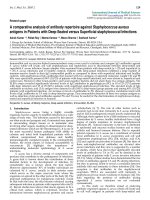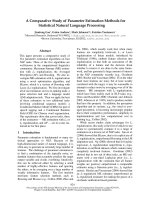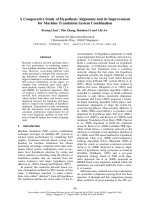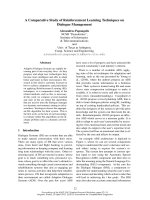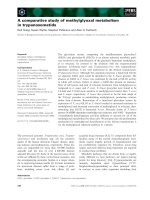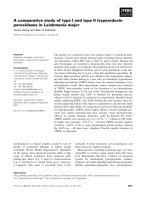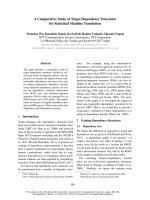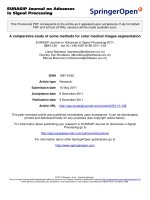Báo cáo y học: "A comparative study of four intensive care outcome prediction models in cardiac surgery patients" pdf
Bạn đang xem bản rút gọn của tài liệu. Xem và tải ngay bản đầy đủ của tài liệu tại đây (572.15 KB, 8 trang )
RESEARCH ARTICLE Open Access
A comparative study of four intensive care
outcome prediction models in cardiac surgery
patients
Fabian Doerr
1
, Akmal MA Badreldin
1
, Matthias B Heldwein
1
, Torsten Bossert
1
, Markus Richter
1
, Thomas Lehmann
2
,
Ole Bayer
3
, Khosro Hekmat
1*
Abstract
Background: Outcome prediction scoring systems are increasingly used in intensive care medicine, but most were
not devel oped for use in cardiac surgery patients. We compared the performance of four intensive care outcome
prediction scoring systems (Acute Physiology and Chronic Health Evaluation II [APACHE II], Simplified Acute
Physiology Score II [SAPS II], Sequential Organ Failure Assessment [SOFA], and Cardiac Surgery Score [CASUS]) in
patients after open heart surgery.
Methods: We prospectively included all consecutive adult patients who underwent open heart surgery and were
admitted to the intensive care unit (ICU) between January 1
st
2007 and December 31
st
2008. Scores were
calculated daily from ICU admission until discharge. The outcome measure was ICU mortality. The performance of
the four scores was assessed by calibration and discrimination statistics. Derived variables (Mean- and Max- scores)
were also evaluated.
Results: During the study period, 2801 patients (29.6% female) were included. Mean age was 66.9 ± 10.7 years and
the ICU mortality rate was 5.2%. Calibration tests for SOFA and CASUS were reliable throughout (p-value not <
0.05), but there were significant differences between predicted and observed outcome for SAPS II (days 1, 2, 3 and
5) and APACHE II (days 2 and 3). CASUS, and its mean- and maximum-derivatives, discriminated better between
survivors and non-survivors than the other scores throughout the study (area under curve ≥ 0.90). In order of best
discrimination, CASUS was followed by SOFA, then SAPS II, and finally APACHE II. SAPS II and APACHE II derivatives
had discrimination results that were superior to those of the SOFA derivatives.
Conclusions: CASUS and SOFA are reliable ICU mortality risk stratification models for cardiac surgery patients. SAPS
II and APACHE II did not perform well in terms of calibration and discrimination statistics.
Background
Scoring systems were introduced into intensive care
medici ne to prov ide the physician with an objectiv e tool
for judging a patient’s condition and likely outcome.
These scores can be used to estimate the severity of dis-
ease and to aid therapeutic decisions. The acute patho-
physiological sequelae of cardiopulmonary bypass are
transient and many physiologic changes may be masked
by multiple system support devices, such as intra-aortic
balloon pumps, ventricular assist devices, hemofiltration
and mechanical ven tilation. The subset of cardiac sur-
gery patients was, therefore, excluded during the devel-
opment of many general scoring sy stems, such as the
Acute Physiology and Chronic Health Evaluation
(APACHE) and the Simplified Acute Physiology Score
(SAPS) [1,2]. Nevertheless, many of these scoring sys-
tems are used in cardiac surgery intensive care units
(ICU) because of the l ack of an appropriate risk index
for this specific subgroup of patients. In central Europe,
the most commonly used postoperative scoring systems
in cardiac ICUs are APACHE II [1], SAPS II [2] and th e
Sequential Organ Failure Assessment (SOFA) [3].
* Correspondence:
1
Department of Cardiothoracic Surgery, Friedrich-Schiller-University of Jena,
Erlanger Allee 101, 07747 Jena, Germany
Full list of author information is available at the end of the article
Doerr et al. Journal of Cardiothoracic Surgery 2011, 6:21
/>© 2011 Doerr et al; licensee BioMed Central Ltd. This is an Open Access article distributed under t he terms of the Creative Commons
Attribution License (http://creativecom mons.org/licenses/by/ 2.0), which permits unrestricted use, distribution, and reproduction in
any medium, provided the original work is properl y cited.
Recently, the Cardiac Surgery Score (CASUS) [4] was
introduced to specifically target cardiac surgery patients,
but it is not yet widely used. In this study, we compared
the mortality prediction of CASUS and the other well-
known ICU scoring systems after cardiac surgery. The
variables included in these four scores are shown in
Table 1.
Methods
This study involved an evaluation of prospectively col-
lected data from all consecutive adult patients admitted
to our ICU after c ardiac surgery. Patients admitted
between January 1
st
2007 and December 31
st
2008 were
included and the study was approved by the Institu-
tional Review Board of Friedrich Schiller University
Hospital (approval no.: 2809-05/10). Only the first
admission was considered for patients who were read-
mitted to the ICU during the study period. Data were
collected from the quality control syste m QUIMS 2.0b
(University Hospital of Muenster, Germany) and from
the intensive care information system COPRA 5.2
(COPRASYSTEM GmbH, Sasbachwalden, Germany),
which is interfaced with patient monitors (Philips Intelli-
Vue MP70, Amsterdam, Netherlands), ventilators (Drae-
ger E vita IV, Luebeck, Germany and Hamilton Galileo,
Bonaduz, Swizerland), blood gas analyzing devices (ABL
800Flex Radiometer, Copenhagen, Denmark) and the
central laboratories.
The attending physician collected the study data of all
scores for the first postoperative week. Two assigned
medical clerks validated the data collection daily.
A senior consultant performed a second periodical vali-
dation. Inconsistency between the raters was resolved by
consensus. There were no missing data. Outcome was
defined as ICU mortal ity. The scores were calculated
using the most abnormal value for each variable per
day. The maximum derivative of any scoring system
(Max-score) was defined as the worst daily score
throughout the whole ICU stay. Mean-score was calcu-
lated by dividing the sum of all daily values during the
ICU stay by the ICU length of stay (ICULOS) in days.
Statistical analyses
Statistical analyses were performed with SPSS software
version 18 (SPSS Inc, Chicago, IL). Graphics were
drawn using Microsoft Excel software. Continuous scale
data are presented as mean ± standard deviation (SD)
and were analyzed using the two-tailed Student’st-test
for independent samples. The Kolmogorov-Smirnov test
showed a normal distribution of t he continuous data.
A p value of < 0.05 was considered as significant. Cali-
bration was performed using the Hosmer-Lemeshow
(HL) test (goodness-of-fit-test) to insure the absence of
a significant discrepancy between predicted and
Table 1 Summary of variables included in the different
postoperative scoring systems
Variables CASUS APACHE II SAPS II SOFA
Cardiovascular system
Blood pressure √√√√
Heart rate √√√
CVP √
Lactate √
IABP √
VAD √
NYHA IV (cardiac) √
Catecholamines √
Respiratory system
Oxygenation √√√√
Respiratory rate √
COPD √
Hypoxia √
Hypercapnia √
Pulmonary hypertension √
Patient dependence on respirator √
Renal system
Creatinine √√ √
Urine output √√
Dialysis √√
Urea √
Hepatic system
Bilirubin √√√
Cirrhosis √
Portale hypertension √
GI bleeding √
Liver collapse √
Hepatic encephalopathy √
Hematological system
Leukocytes √√
Platelets √√
Hematocrit √
Central nervous system
GCS √√√
Neurologic state √
Electrolyte/Metabolic status
Sodium √√
Potassium √√
Bicarbonate √√
Patient data
Age √√
Chronical disease
Metastasis/tumor √√
Leukemia √√
AIDS √√
Therapeutic low immunity √
ICU-admission
Elective surgery √√
Internal disease √√
Doerr et al. Journal of Cardiothoracic Surgery 2011, 6:21
/>Page 2 of 8
observed mortality. Calibration was considered good
when there was a low c2 value and a high p value
(>0.05). Discrimination (ability of a scoring model to dif-
ferentiate between survival and death) was evaluated
with receiver-operating-characteristic (ROC) curves; the
area under the curve (A UC) indicates the discriminative
ability of the scores, i.e., the ability to discriminate survi-
vors from non-survivors. AUCs enable direct compari-
son of different scoring systems: An AUC of 0.5 (a
diagonal line) is equivalent to random chance, AUC
>0.7 indicates a moderate prognostic model, and AUC
>0.8 (a bulbous curve) indicates a good prognostic
model. The overall correct classification (OCC) (the
ratio of number of correctly predicted survivors and
non-survivors to the total number of pati ents) values of
the scores were calculated. The risk of mortality is given
as odds ratios for all scores with 95%-confidence inter-
vals. All statistical analyses were performed from ICU
day 1 (n = 2801) (operative day) to day 6 (n = 431
patients) only, in order to obtain accurate statistical
results and to avoid a small number of patients. The
preoperative logistic and additive EuroSCORE were also
statistically tested.
Results
The study included 2801 patients who were admitted to
the ICU over the two-year period; 29.6% (n = 830) were
female, and mean age was 66.9 ± 10.7 years (range of
19-89 years). The types of surgical procedures are shown
in Table 2. ICULOS was 4.3 ± 6.8 days (range 1-189 days,
median 2.0 days, 75
th
percentile 4.0 days) and ICU mor-
tality was 5.2% (n = 147). The preoperative collected
mean additive EuroSCORE was 6.3 ± 3.6 and the mean
logistic EuroSCORE was 9.9 ± 12.9 (median 5.3, 75
th
per-
centile 11.3).
Table 3 summarizes the OCC, calibration and discrimi-
nation of all four models from the first ICU day to day 6
and for both preoperative EuroSCORE models. There
were no significant differences between expected and
observed mortality for CASUS, SOFA and the preopera-
tive additive EuroSCORE using the HL-test, but there
were differences for the preoperative logistic EuroSCORE
(p = 0.01), SAPS II (p < 0.05 on ICU admission and days
2, 3 and 5) and APACHE II (p < 0.05 on days 2 and 3).
Figure 1 shows the ROCs of all the postoperative model s
for the first six ICU days. The AUC for CASUS (≥ 0.90)
was greater than those of the other scoring systems on all
studied days; the largest AUC was achieved with CASUS
on the second ICU day (AUC = 0.97) (Table 3, Figure 2).
SOFA performed better than APACHE II and SAPS II in
this statistical analysis. The OCC was greater for CASUS
than for the other scores on all days with the best result
on the second ICU day (OCC = 96.9%).
Table 4 shows the results for the statistical evaluation
of the score-derivatives. There were no significan t differ-
ences between expected and observed mortality using the
HL-test. CASUS again had the best discrimination. In the
ROC test, in cont rast to the results for the original
scores, the derivative s of SAPS II and of APACHE II per-
formed better than the derivatives of SOFA. All derived
scores had higher OCCs than the original scores.
Discussion
Patients undergoing cardiac surgery show temporary
pathophysiological effects related to the heart-lung-
machine [5,6] that can influence the values of the post-
operative scoring systems [7] and may make them
unreliable in this p opulation. These effects include the
Table 2 Type of surgery in the study population
Operation number %
CABG 1526 54.5
Isolated valve surgery 635 22.7
Combined CABG & valve surgery 381 13.6
Ascending aorta and aortic arch surgery 60 2.1
Combined ascending aorta & valve surgery 116 4.1
Combined ascending aorta & coronary surgery 5 0.2
Cardiac transplantation 24 0.9
Congenital, cardiac tumors, pulmonary embolectomy, Assist device implantation 54 1.9
Total 2801 100
CABG: Coronary artery bypass grafting.
Table 1 Summary of variables included in the different
postoperative scoring systems (Continued)
Emergency OP √√
Others
Temperature √√
pH √
CVP: central venous pressure; IABP: intra-aortic balloon pump; VAD: ventricular
assist device; COPD: chronic obstructive pulmonary disease; GI: gastrointestinal;
GCS: Glasgow coma scale; AIDS: acquired immunodeficiency disease.
Doerr et al. Journal of Cardiothoracic Surgery 2011, 6:21
/>Page 3 of 8
relatively long mechanical ventilation time needed to
stabilize these patients [8,9] and the postoperative seda-
tion that limits the role of the Glasgow Coma Scale
(GCS) a s a prognostic parameter [10]. Electrolyte- and
blood glucose imbalances are also frequent [4]. All these
factors are tempo rary and have a limited effect on prog-
nosis. In addition, most currently used scoring systems
ignore some of the parameters that can influence out-
comes in these patients. The most common examples of
this are the use of intra-aortic balloon pumps (IABP)
and ventricular assist devices (VAD), and the presence
of postoperative low cardiac output syndrome (LCOS)
[5,6,8,11]. In 2005, CASUS [4] was suggested as a spe-
cialized cardiac surgery scoring system that took i nto
account the special circumstances encountered in the
ICU after cardiac surgery. However, many ICUs are still
using the general postoperative risk stratification models
for cardiac surgery patients, notably, in central Europe,
the SOFA, APACHE II and SAPS II scores. Postopera-
tive risk stratification is increasingly used, especially in
cardiac surgery, and we believed it was important t o
compare these widely used scoring systems with the
relatively new model (CASUS) to try and identify the
optimal tool in this field.
The APACHE II model [1], published in 1985, was
developed to simplify the original APACHE model and
has become the most frequently used general mortality
prediction model. APACHE II has been extensively vali-
dated, and despite being the oldest system, it still per-
forms well [12]. More recent versions (APACHE III and
IV) have n ot been widely ado pted. All the APACHE
models are based on the most abnormal values registered
during the first 24 h after ICU admission. However,
because several studies [13,14] have supported serial
daily usage of postoperative risk stratification models, we
chose to evaluate APACHE II on all ICU days. In our
Table 3 Day 1-6: Logistic regression, OCC, calibration (HL), discrimination (ROC) for EuroSCORE, CASUS, SOFA, SAPSII,
APACHEII
Day Scoring model Logistic Regression OCC HL test ROC-Analysis
O R 95%-CI % c
1
p-value AUC 95%-CI
Preoperative (2801) Add-Euro 1.25 1.20-1.30 94.7 9.10 0.33 0.71 0.64-0.79
Log-Euro 1.04 1.03-1.05 94.7 19.75 0.01 0.71 0.63-0.78
CASUS 1.55 1.48-1.64 96.0 3.65 0.82 0.93 0.91-0.95
ICU-Day 1 (2801) SOFA 1.70 1.58-1.82 95.3 7.90 0.34 0.85 0.81-0.88
SAPS II 1.08 1.07-1.10 95.0 36.60 <0.001 0.83 0.79-0.86
APACHE II 1.17 1.14-1.19 95.0 5.28 0.626 0.78 0.75-0.82
CASUS 1.50 1.43-1.58 96.9 13.97 0.05 0.97 0.96-0.98
ICU-Day 2 (2769) SOFA 1.64 1.54-1.76 95.3 6.75 0.56 0.91 0.88-0.93
SAPS II 1.09 1.08-1.10 95.4 33.87 <0.001 0.89 0.87-0.91
APACHE II 1.20 1.17-1.23 95.3 30.63 <0.001 0.87 0.85-0.90
CASUS 1.37 1.31-1.43 93.8 10.29 0.17 0.94 0.93-0.96
ICU-Day 3 (1234) SOFA 1.55 1.44-1.66 90.8 6.45 0.60 0.90 0.88-0.93
SAPS II 1.09 1.08-1.10 90.9 17.15 0.03 0.89 0.87-0.92
APACHE II 1.20 1.16-1.23 91.0 18.13 0.02 0.86 0.83-0.89
CASUS 1.36 1.29-1.43 92.4 3.66 0.82 0.93 0.91-0.96
ICU-Day 4 (815) SOFA 1.50 1.39-1.62 89.3 8.35 0.40 0.89 0.86-0.91
SAPS II 1.08 1.07-1.10 89.3 12.18 0.143 0.87 0.84-0.91
APACHE II 1.18 1.14-1.22 88.6 8.42 0.297 0.82 0.78-0.86
CASUS 1.34 1.26-1.41 91.2 8.08 0.33 0.92 0.89-0.95
ICU-Day 5 (566) SOFA 1.51 1.39-1.65 86.9 2.46 0.96 0.89 0.85-0.92
SAPS II 1.08 1.06-1.09 86.0 18.99 0.015 0.86 0.83-0.90
APACHE II 1.16 1.12-1.20 86.2 14.30 0.07 0.79 0.74-0.84
CASUS 1.32 1.25-1.41 89.5 4.71 0.79 0.90 0.86-0.94
ICU-Day 6 (430) SOFA 1.47 1.35-1.61 85.6 3.98 0.86 0.88 0.84-0.91
SAPS II 1.07 1.05-1.08 85.6 5.11 0.75 0.82 0.77-0.87
APACHE II 1.14 1.10-1.19 85.8 5.96 0.65 0.75 0.69-0.81
95%-CI: 95%-confidence interval, Add-Euro: additive EuroSCORE, AUC: Area under ROC curve, HL: Hosmer-Lemeshow, Log-Euro: logistic EuroSCORE, OCC: overall
correct classification, CC: tio for risk of mortality, OR: Odds ratio for risk of mortality, ROC: receiver operating characteristic.
Doerr et al. Journal of Cardiothoracic Surgery 2011, 6:21
/>Page 4 of 8
study, APACHE II had the worst discrimination of the
four models studied but its calibration was better than
that of SAPS II.
SAPS II was developed in 1994 [2] based on a Eur-
opean/North Americ an database, which included 13,152
patients. Logistic regression analysis was used t o select
variables, and for we ighting and conversion of the score
to give the probability of hospital mortality for ICU
patients over the age of 18. Although cardiac surgery
patients were originally excluded from the score’s target,
it is used in many cardiac ICUs. SAPS II has been
extensively studied and validated. There seems to be
Figure 1 Day 1-6: ROC-curves of CASUS, SOFA, APACHE II, SAPS II and their derivatives.
Doerr et al. Journal of Cardiothoracic Surgery 2011, 6:21
/>Page 5 of 8
quite convincing evidence of the ability to maintain
good discrimination across different populations, but
calibration is often poor [15,16 ]. Our study in cardia c
surgery patients, confirmed the poor calibration of SAPS
II and its discrimination was worse th an that o f SOFA
and CASUS. SAPS III [17] was introduced in 2005 in an
attempt to overcome shortcomings related to different
case-mixes and lead-time bias of SAPS II. However, its
calibration and discrimination set were shown to vary
widely around the world [12] so that many centers in
central Europe still use the older version.
The SOFA was originally developed in 1996 as a mor-
bidity risk stratification model for patients with sepsis
[3]. Because of its good performance and reliability,
SOFA is widely used as a scoring model for ICU
patients not only for morbidity but also for m ortality
prediction [7]. In 2003, Ceriani et al. [14] suggested the
use of SOFA in cardiac surgery patients. Based on the
good results they obtained in 218 patients, they con-
cluded that SOFA was applicable in cardiac surgery
without any need for specific modifications. S OFA com-
prises separate daily scores for respiratory, renal,
cardiovascular, central nervous, coagula tion, and hepatic
systems. The scores can be used in several ways, as indi-
vidual scores (for each organ), as the sum of scores on a
single ICU day, or as the sum of the worst scores during
the ICU stay.
CASUS was developed based on retrospective ana-
lyses to identify descriptors of mortality and multio r-
gan dysfunction in postoperative cardiac surgical
patients. It was then evaluated prospectively in 3230
patients in a single center study [4]. The main g oal
was to develop a scoring model that was specific to
this type of patient and had a minimum number of
descriptors. CASUS is, therefore, a compact score
index with only ten, readily available descriptors. This
scoring system has not yet been externally validated in
multicenter studies, and accordingly, has not yet
gained much popularity.
The ideal scoring system should not only be simple
and reproducible but also reliable. This reliability can
be assessed using calibration and discriminatio n tests,
considered by the European Society of Intensive Care
Medicine (ESICM) to be the best methods to validate
score systems and prognostic parameters [18]. It has
been argued that perfect discrimination is important in
order to evaluate an individual p atient’sriskusinga
scoring system, whereas for clinical trials or comparison
of care between ICUs better calibration is needed [19].
Accordingly, validations of scoring systems in the litera-
ture have frequently been achieved using good discrimi-
nation tests, although the HL test has o ften resulted in
unreliable calibration. The HL test is very sensitive to
thesizeofthestudypopulationwithlargenumbersof
patients resulting in unreliable calibration [20]. This fact
is applicable to study populations larger than 5000
patients [20], which was not the case in our study. In
other words, if the HL-test, in studies with more than
5000 patients, is significant this does not necessarily
Figure 2 Day 1-6: Areas under the ROC-curves of CASUS, SOFA,
APACHE II and SAPS II.
Table 4 Logistic regression/odds ratio, OCC, calibration (HL), discrimination (ROC) for CASUS, SOFA, SAPSII, APACHEII
derivatives
Derivative of the Scoring model Logistic Regression OCC HL test ROC-Analysis
O R 95%-CI % c
1
p-value AUC 95%-CI
Mean-CASUS 2.04 1.85-2.62 98.3 5.75 0.68 0.991 0.987-0.995
Mean-SOFA 2.76 2.43-3.12 97.3 11.33 0.18 0.96 0.94-0.98
Mean-SAPS II 1.26 1.22-1.29 97.2 5.22 0.73 0.982 0.975-0.988
Mean-APACHE II 1.64 1.54-1.75 96.2 3.78 0.88 0.97 0.96-0.97
Max-CASUS 1.60 1.51-1.70 97.8 2.12 0.95 0.98 0.97-0.99
Max-SOFA 1.81 1.69-1.95 95.6 10.54 0.16 0.92 0.90-0.95
Max-SAPS II 1.15 1.13-1.18 95.9 3.75 0.88 0.95 0.94-0.96
Max-APACHE II 1.35 1.30-1.40 95.5 14.38 0.07 0.93 0.91-0.95
95%-CI: 95%-confidence interval, AUC: Area under ROC curve, HL: Hosmer-Lemeshow, OCC: overall correct classification, OR: Odds ratio for risk of mortality, ROC:
receiver operating characteristic.
Doerr et al. Journal of Cardiothoracic Surgery 2011, 6:21
/>Page 6 of 8
mean that the scoring systems are not useful or are
unreliable [20].
However, our study, with a more optimal siz e of study
population, showed that APACHE II and SAPS II are
not suitable for use in cardiac surgery patients. CASUS
and SOFA ha d an acceptable performance with the HL-
test compared to the other two scores. CASUS was
clearly superior in its ability to discriminate between
survival a nd death on all days. This predictive property
allows complications to be anticipated in individual
patients and should alert residents, especially those with
relatively little experience, to ask for help. The OCC
(the ratio of correctly predicted number of survivors
and non-survivors to the total number of patients) was
also better in CASUS than in the other scores. We
decided not to compare the different scores using odds
ratios, because concl usions from such analyses can be
distorted, as the maximum points in the different scor-
ing s ystems vary significantly. Nevertheless odds ratios
are useful tools to estimate the risk of mortality. H ence,
for example, results can be influenced by different ino-
tropic regimes or fluid replacement strategies in differ-
ent hospitals. The assessment of the central nervous
system may also affect results because the GCS is
affected by sedation, anes thesia and paralysis [10,21,22] ,
and calculation requires clinical evaluation, which may
be biased by subjective interpretation [6,10,22]. CASUS
is not affected by these problems. Its simple variable,
‘ neurologic state’ , can be calculated in less than one
minute per patient per day. The parameters included in
any scoring system influence its usefulness in different
populations of patients. It is, therefore, perhaps not sur-
prising that CASUS, which was specifically constructed
for cardiac surgery patients, is superior to general sever-
ity systems in this group.
Mean- and max-score derivatives were introduced for
SOFA by Moreno et al. [23] in 1999 and Ferreira et al.
[24] in 2001. These methods were extended by Ceriani
et al. [14] in 2003. We chose to calculate mean- and
max-values for all four scores. However, it should be
remembered that calculating the mean- and max-values
adds some degree of selectivity to the model. The mean-
derivative of a model reflects the overall average, whereas
the max-derivative highlights the peak of organ dysfunc-
tion during the postoperative ICU stay; both are asso-
ciated with the ICULOS, and thus allow a defined
outcome prediction. The mean- and max-derivatives of
all scores demonstrated better calibration, discrimination
and OCC than the original models.
Similar to other studies, we detected a severe decrease
in the study population on the third day because
uncomplicated cases had been transferred to the general
floor (Table 3). It is therefore important that a score is
reliable during the first two days so that patients at risk
are not discharged too early potentially leading to ICU-
readmission and/or prolonged hospital stay, both of
which are associated with higher mortality rates [25,26].
The good prognostic abilities of SOFA and CASUS in
this study suggest they could be used to identify high-
risk patients, enabling certain precautions to be put into
place, such as daily monitoring of physiological dysfunc-
tion [27], and allowing prognoses and therapeutic
choices, including withdrawal of therapy, to be dis-
cussed and reconsidered [28]. Nevertheless, no scoring
system can replace clinical evaluation at a patient’s bed-
side; they can only serve as an objective tool in decision
making. Although scoring systems may provide an indi-
cation of disease severity and prognosis in individual
patients and assist in overall patient assessment along
with full clinical evaluation and other available para-
meters, they are designed for use in groups of patients
and should never be the sole basis for therapeutic
decisions [29].
Conclusion
SOFA and CASUS are reliable tools for risk stratifica-
tion in cardiac surgery patients. CASUS is more accu-
rate than SOFA in mortality prediction. In contrast,
APACHE II and SAPS II are not the tools of choice f or
this group of patients.
Acknowledgements
We thank Dr. Tobias Berg of Friedrich-Schiller-University, Jena, Germany for
his substantial technical and statistical support, and for the realization of the
online CASUS calculation, which can be found on the following homepages
(English version) and
(German version). Furthermore an App for iPhone, iPad and iPod touch is
available for free on the iTunes App store: />cardiac-icu/id389965786?mt=8.
Author details
1
Department of Cardiothoracic Surgery, Friedrich-Schiller-University of Jena,
Erlanger Allee 101, 07747 Jena, Germany.
2
Institute of Medical Statistics,
Computer Sciences and Documentation, Friedrich-Schiller-University of Jena,
Bachstrasse 18, 07743 Jena, Germany.
3
Department of Anesthesiology and
Intensive Care Medicine, Friedrich-Schiller-University of Jena, Erlanger Allee
101, 07747 Jena, Germany.
Authors’ contributions
FD: substantial contributions to conception and design; acquisition, analysis
and interpretation of data; drafting the manuscript. AB: substantial
contributions to conception and design; revising the manuscript critically for
important intellectual content. MH: acquisition and analysis of data; revising
the manuscript it critically for important intellectual content. TB: final
approval of the version to be published. MR: revising the manuscript
critically for important intellectual content; final approval of the version to
be published. TL: substantial contributions to statistical methods and
analyses. OB: final approval of the version to be published. KH: substantial
contributions to conception and design; interpretation of data; revising the
manuscript critically for important intellectual content. All author s read and
approved the final manuscript.
Competing interests
The authors declare that they have neither a financial nor a non-financial
competing interest.
Doerr et al. Journal of Cardiothoracic Surgery 2011, 6:21
/>Page 7 of 8
Received: 31 October 2010 Accepted: 1 March 2011
Published: 1 March 2011
References
1. Knaus W, Draper E, Wagner D, Zimmerman J: APACHE II: a severity of
disease classification system. Crit Care Med 1985, 13:818-829.
2. Le Gall JR, Lemeshow S, Saulnier F: A new Simplified Acute Physiology
Score (SAPS II) based on a European/North American multicenter study.
JAMA 1993, 270:2957-2963.
3. Vincent JL, Moreno R, Takala J, Willatts S, De Mendonca A, Bruining H,
Reinhart K, Suter PM, Thijs LG: The SOFA (Sepsis-related Organ Failure
Assessment) score to describe organ dysfunction/failure. On behalf of
the Working Group on Sepsis-Related Problems of the European Society
of Intensive Care Medicine. Intensive Care Med 1996, 22:707-710.
4. Hekmat K, Kroener A, Stuetzer H, Schwinger RH, Kampe S, Bennink GB,
Mehlhorn U: Daily assessment of organ dysfunction and survival in
intensive care unit cardiac surgical patients. Ann Thorac Surg 2005,
79:1555-1562.
5. Ryan TA, Rady MY, Bashour CA, Leventhal M, Lytle B, Starr NJ: Predictors of
outcome in cardiac surgical patients with prolonged intensive care stay.
Chest 1997, 112:1035-1042.
6. Turner JS, Morgan CJ, Thakrar B, Pepper JR: Difficulties in predicting
outcome in cardiac surgery patients. Crit Care Med 1995, 23:1843-1850.
7. Weiss YG, Merin G, Koganov E, Ribo A, Oppenheim-Eden A, Medalion B,
Peruanski M, Reider E, Bar-Ziv J, Hanson WC, Pizov R: Postcardiopulmonary
bypass hypoxemia: a prospective study on incidence, risk factors, and
clinical significance. J Cardiothorac Vasc Anesth 2000, 14:506-513.
8. Kollef MH, Wragge T, Pasque C: Determinants of mortality and multiorgan
dysfunction in cardiac surgery patients requiring prolonged mechanical
ventilation. Chest 1995, 107:1395-1401.
9. Rady MY, Ryan T, Starr NJ: Perioperative determinants of morbidity and
mortality in elderly patients undergoing cardiac surgery. Crit Care Med
1998, 26:225-235.
10. Marik PE, Varon J: Severity scoring and outcome assessment.
Computerized predictive models and scoring systems. Crit Care Clin 1999,
15:633-646.
11. Higgins TL, Estafanous FG, Loop FD, Beck GJ, Lee JC, Starr NJ, Knaus WA,
Cosgrove DM: ICU admission score for predicting morbidity and
mortality risk after coronary artery bypass grafting. Ann Thorac Surg 1997,
64:1050-1058.
12. Strand K, Flaatten H: Severity scoring in the ICU: a review. Acta
Anaesthesiol Scand 2008, 52:467-478.
13. Badreldin AM, Kroener A, Heldwein MB, Doerr F, Vogt H, Ismail MM,
Bossert T, Hekmat K: Prognostic value of daily cardiac surgery score
(CASUS) and its derivatives in cardiac surgery patients. Thorac Cardiovasc
Surg 2010, 58:1-6.
14. Ceriani R, Mazzoni M, Bortone F, Gandini S, Solinas C, Susini G, Parodi O:
Application of the sequential organ failure assessment score to cardiac
surgical patients. Chest 2003, 123:1229-1239.
15. Harrison DA, Brady AR, Parry GJ, et al: Recalibration of risk prediction
models in a large multicenter cohort of admissions to adult, general
critical care units in the United Kingdom. Crit Care Med 2006,
34:1378-1388.
16. Aegerter P, Boumendil A, Retbi A, et al: SAPS II revisited. Intensive Care Med
2005, 31:416-423.
17. Moreno RP, Metnitz PG, Almeida E, et al: SAPS 3 Investigators. SAPS 3 -
from evaluation of the patient to evaluation of the intensive care unit.
Part 2: development of a prognostic model for hospital mortality at ICU
admission. Intensive Care Med 2005, 31:1345-1355.
18. 2nd European Consensus Conference in Intensive Care Medicine:
Predicting outcome in ICU patients. Intensive Care Med 1994, 20:390-397.
19. Sakr Y, Krauss C, Amaral A, Réa-Neto A, Specht M, Reinhart K, Marx G:
Comparison of the performance of SAPS II, SAPS 3, APACHE II, and their
customized prognostic models in a surgical intensive care unit. Br J
Anaesth 2008, 101:798-803.
20. Kramer AA, Zimmerman JE: Assessing the calibration of mortality
benchmarks in critical care: The Hosmer-Lemeshow test revisited. Crit
Care Med 2007, 35:2212-2213.
21. Vincent JL, Ferreira F, Moreno R: Scoring systems for assessing organ
dysfunction and survival. Crit Care Clin 2000, 16:353-366.
22. Marshall JC, Cook DJ, Christou NV, Bernard GR, Sprung CL, Sibbald WJ:
Multiple organ dysfunction score: a reliable descriptor of a complex
clinical outcome. Crit Care Med 1995, 23:1638-1652.
23. Moreno R, Vincent JL, Matos R, Mendonca A, Cantraine F, Thijs L, Takala J,
Sprung C, Antonelli M, Bruining H, Willatts S: The use ofmaximum SOFA
score to quantify organ dysfunction/failure in intensive care. Results of a
prospective, multicentre study. Working Group on Sepsis Related
Problems of the ESICM. Intensive Care Med 1999, 25:686-696.
24. Ferreira FL, Bota DP, Bross A, Melot C, Vincent JL: Serial evaluation of the
SOFA score to predict outcome in critically ill patients. JAMA 2001,
286:1754-1758.
25. Chung DA, Sharples LD, Nashef SAM: A case-control analysis of
readmissions to the cardiac surgical intensive care unit. Eur J
Cardiothorac Surg 2002, 22:282-286.
26. Michalopoulos A, Stavridis G, Geroulanos S: Severe sepsis in cardiac
surgical patients. Eur J Surg 1998, 164:217-222.
27. Hutchinson C, Craig S, Ridley S: Sequential organ scoring as a measure of
effectiveness of critical care. Anaesthesia 2000, 55:1149-1154.
28. Pintor PP, Colangelo S, Bobbio M: Evolution of case-mix in heart surgery:
from mortality risk to complication risk. Eur J Cardiothorac Surg 2002,
22:927-933.
29. Heijmans JH, Maessen JG, Roekaerts PMHJ: Risk stratification for adverse
outcome in cardiac surgery. Eur J Anaesthesiol 2003, 20:515-527.
doi:10.1186/1749-8090-6-21
Cite this article as: Doerr et al.: A comparative study of four intensive
care outcome prediction models in cardiac surgery patients. Journal of
Cardiothoracic Surgery 2011 6:21.
Submit your next manuscript to BioMed Central
and take full advantage of:
• Convenient online submission
• Thorough peer review
• No space constraints or color figure charges
• Immediate publication on acceptance
• Inclusion in PubMed, CAS, Scopus and Google Scholar
• Research which is freely available for redistribution
Submit your manuscript at
www.biomedcentral.com/submit
Doerr et al. Journal of Cardiothoracic Surgery 2011, 6:21
/>Page 8 of 8
